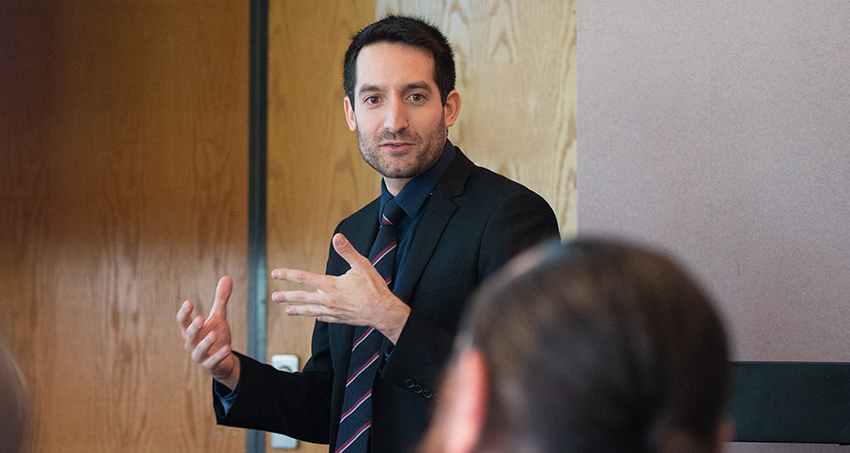Supreme Court Discussion Draws a Crowd
While the lecture focused mainly on the Court’s history, the subsequent Q&A session allowed for a dialogue about current events.By: Meghan Kita Tuesday, October 16, 2018 11:14 AM
 Ross Dardani, visiting assistant professor of political science, speaks to a crowd about the history of the Supreme Court.
Ross Dardani, visiting assistant professor of political science, speaks to a crowd about the history of the Supreme Court.In the GQ Annex, the tables are arranged in a square, with a few dozen people sitting around them eating sandwiches. Another dozen or so seats around the perimeter of the room hold the overflow: the students, faculty and community members who weren’t able to get seats at the table. The crowd is here for a lunchtime presentation from Ross Dardani, visiting assistant professor of political science, called “The Least Dangerous Branch? The Myth of the Supreme Court in American Politics.” And why does Dardani think the room is full?
“I recognize it’s the food,” he says, to laughs. “I assume, also, that the turnout is high because the Supreme Court has been in the news. But my plan is not to talk about that during my lecture.”
Instead, he speaks about the Court’s history, about whether and how it has exerted influence in the past and about its reputation as a collegial, independent institution. And he speaks quickly, working through some famous cases while throwing in fun facts and asides.
Attendees learn that the Supreme Court met in the basement of the Capitol until 1935, that the front door atop the Supreme Court Building steps has not been used for public access since a sword-wielding intruder used it to enter in the 1990s, that a recent poll showed only 43 percent of Americans could name even a single justice. Attendees also learn, at length, about Brown v. Board of Education, a decision that’s often credited with ending segregation when the reality is much more complicated.
Dardani uses a metaphor to explain how the Supreme Court has historically exerted influence, including in Brown v. Board of Education: “Pretend I have a water balloon and I want to throw it at Dr. Hashim.” (That’s Political Science Professor S. Mohsin Hashim, who’s at the talk and laughs at the joke.) “I’m going to throw it at him and I’m going to miss. What happens to the water balloon? I didn’t hit him, but what happens? It still explodes. There’s still an effect. That’s a good way of thinking about how the Supreme Court exerts influence in the American political system.”
The Q&A session after the lecture gives Dardani and attendees the opportunity to discuss more recent decisions and the reason the Supreme Court has been in the news: the hearings about and subsequent confirmation of Justice Brett Kavanaugh. Political Science Professor Jack Gambino brings up former Justice John Paul Stevens’s assertion that Kavanaugh isn’t fit to sit on the Court due to the partisan nature of his comments to the Senate Judiciary Committee.
“I don't know how you recover from that,” Dardani replies. “That really may cost Brett Kavanaugh. I don’t think he’s going to be writing any major opinions. He’s going to forever be known for the confirmation hearings. If you have him as the fifth vote in another case like Bush v. Gore, I think the Court’s legitimacy craters.”
Dardani’s lecture was part of Elections 2018: The Politics of Urgency and Uncertainty, a nonpartisan event series sponsored by Muhlenberg’s Political Science Department.
